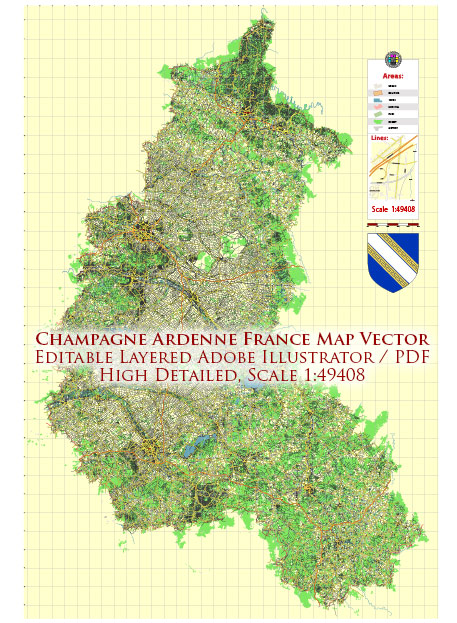A general overview of the historical development of railroads and road systems in the Champagne-Ardenne region of France.
Vectormap.Net provide you with the most accurate and up-to-date vector maps in Adobe Illustrator, PDF and other formats, designed for editing and printing. Please read the vector map descriptions carefully.
Railroads:
- Early Railways (19th Century): The introduction of railways in Champagne-Ardenne, like in many other regions of France, can be traced back to the 19th century. The construction of the first railway lines aimed to connect major cities and facilitate the transportation of goods and passengers.
- Industrialization and Expansion (Late 19th to Early 20th Century): The late 19th and early 20th centuries witnessed the expansion of the railway network in the region. Railways played a crucial role in supporting industrialization, enabling the efficient transport of raw materials and finished products.
- World Wars Impact: The two World Wars had a significant impact on the railway infrastructure. During wartime, railroads were vital for troop movements and logistics. However, like in many other regions, the railways suffered damage during conflicts and required reconstruction and modernization in the post-war period.
- Post-War Modernization: After World War II, the French railway system, including the lines in Champagne-Ardenne, underwent modernization efforts. Electrification of rail lines and the introduction of high-speed trains (TGV) in later decades improved transportation efficiency and speed.
- Current State: As of my last knowledge update, Champagne-Ardenne, like other regions in France, is part of the national railway network operated by SNCF (Société Nationale des Chemins de fer Français). The region is served by various train services, connecting its cities to other parts of France.
Road Systems:
- Historical Roads: Champagne-Ardenne has a history of well-established roads dating back to ancient times. Historical routes and highways were essential for trade, communication, and the movement of people.
- Medieval and Renaissance Periods: Roads continued to be important during the medieval and Renaissance periods. The maintenance and improvement of existing roads were crucial for regional connectivity and economic activities.
- 18th and 19th Centuries: Similar to other regions in France, the 18th and 19th centuries saw improvements in road infrastructure, including better road surfaces and the construction of bridges. This period marked the transition from traditional transportation means to the early forms of modern road systems.
- 20th Century: The 20th century witnessed significant developments in road infrastructure, especially with the rise of automobiles. The construction of highways and national roads contributed to better regional connectivity and facilitated faster transportation.
- Current State: As of my last update, the road system in Champagne-Ardenne is part of the broader French road network. The region is connected by a network of highways, national roads, and local roads, providing comprehensive transportation options for residents and visitors.
In summary, the history of railroads and road systems in Champagne-Ardenne reflects the broader trends in French transportation infrastructure, spanning centuries of development to meet the evolving needs of society and the economy.


 Author: Kirill Shrayber, Ph.D.
Author: Kirill Shrayber, Ph.D.